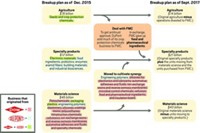Advertisement
Grab your lab coat. Let's get started
Welcome!
Welcome!
Create an account below to get 6 C&EN articles per month, receive newsletters and more - all free.
It seems this is your first time logging in online. Please enter the following information to continue.
As an ACS member you automatically get access to this site. All we need is few more details to create your reading experience.
Not you? Sign in with a different account.
Not you? Sign in with a different account.
ERROR 1
ERROR 1
ERROR 2
ERROR 2
ERROR 2
ERROR 2
ERROR 2
Password and Confirm password must match.
If you have an ACS member number, please enter it here so we can link this account to your membership. (optional)
ERROR 2
ACS values your privacy. By submitting your information, you are gaining access to C&EN and subscribing to our weekly newsletter. We use the information you provide to make your reading experience better, and we will never sell your data to third party members.
Business
Investor puts out own version of the DowDuPont split
Activist Daniel Loeb argues Dow’s specialty chemicals are better suited for the specialty products spin-off
by Alexander H. Tullo
May 24, 2017
| A version of this story appeared in
Volume 95, Issue 22

Activist investor and large Dow Chemical shareholder Daniel S. Loeb thinks he has a better way to break DowDuPont into separate firms than what Dow and DuPont are planning. He estimates his plan would unlock $20 billion in shareholder value.
Dow and DuPont expect to form DowDuPont in August. The company would then split up into three separate firms about 18 months later.
As currently planned, a material science firm with headquarters in Midland, Mich. will house plastics businesses from both companies, Dow petrochemical operations, Dow specialty chemicals such as coatings materials, and the former Dow Corning silicones business.
A specialty products firm with headquarters in Wilmington, Del., will inherit electronic materials businesses from both firms as well as DuPont’s safety and protection, nutrition and health, and industrial biosciences units.
A third firm, also based in Wilmington, will combine crop protection chemicals and seeds businesses.
Loeb’s investment firm, Third Point, released a presentation on May 24 outlining an alternative way to break up the companies.
The silicones business, Third Point says, belongs in the specialty products company, as do DuPont’s engineering plastics business and Dow’s consumer care and energy and water units.
DuPont’s Tyvek polyolefin fabric business should go to material science, although other safety and protection businesses, such as DuPont’s Kevlar fibers, should stay in the specialty products company.
Third Point argues that its way better pairs businesses that align with each other. For instance, Dow’s food ingredients business is currently earmarked for the material science company. Third Point says it fits better with the DuPont nutrition and health business, which makes probiotics and other products for food.
Third Point further says the four units that would make up the specialty products firm—electronic materials, nutrition, specialty materials, and silicones—would have sharp focus on their respective markets and could potentially even stand alone as their own public companies. “In our experience, management teams excel when allowed to chart their own destiny,” the document says.
Third Point points to former Dow and DuPont units such as Trinseo, the former Dow styrenics unit; Axalta, the ex-DuPont paint business; and Chemours, the old DuPont commodity chemicals business, which have all seen large increases in value since their respective separations.
Third Point contends its rearrangement of the businesses would unlock $20 billion in value for investors because the specialty products firm will trade at a higher multiple—the ratio of its stock price to earnings.
In 2014, Dow management and Third Point battled over Third Point’s plan to split Dow into separate specialty and commodity chemical companies. They called a truce at the end of the year. Dow and DuPont negotiated their merger in 2015.
Dow and DuPont say their own split-up plan isn’t set in stone. “The boards of Dow and DuPont have agreed to conduct a comprehensive review of the business composition of each division,” the firms say. “The two companies are fully aligned regarding the objective of the review, and we continually solicit and welcome input from our shareholders.”





Join the conversation
Contact the reporter
Submit a Letter to the Editor for publication
Engage with us on Twitter